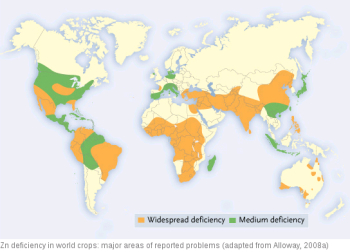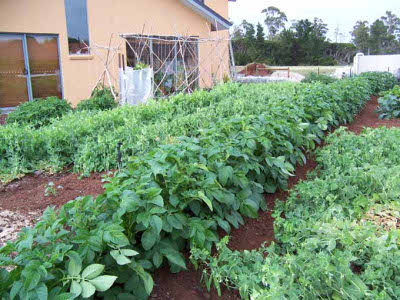
Micronutrient deficiencies in the soil end up on the plate
 USDA
data shows that the average nutritional content of grocery store
vegetables has declined by 25 to 33% over the last 25 years. Read
that line again, because this is a phenomenal finding! You need
to eat a third to a quarter again as many vegetables as your
grandparents did to be
healthy.
USDA
data shows that the average nutritional content of grocery store
vegetables has declined by 25 to 33% over the last 25 years. Read
that line again, because this is a phenomenal finding! You need
to eat a third to a quarter again as many vegetables as your
grandparents did to be
healthy.
Part of the reason for
this decline in nutrition can be attributed to
the vegetable varieties being grown today. Solomon writes that
modern plant varieties --- both hybrids and open-pollinated "heirlooms"
--- are less nutritious than those developed before 1870. His
reasoning for why this decline came about seems a bit strained to me,
so I'll let you check out Gardening
When It Counts
and read for yourself.
A more solid cause for
the lack of nutrition in our vegetables is a decline of soil
micronutrient levels in recent years. The map above clearly shows
that the entire
continental United States suffers from a medium to widespread zinc
micronutrient deficiency, and other micronutrients show a similar
decline. If the soil doesn't have a certain micronutrient in
it, there's no way the vegetables grown there will supply that
micronutrient to your body.
 Steve Solomon argues that fertilizing our
gardens primarily with
compost and manure from the surrounding area can accentuate these
micronutrient deficiencies. Manure quality will vary widely
depending on what the animals were fed, with animals raised on
substandard pasture producing micronutrient deficient manure.
Similarly, if you make compost out of your garden waste, it will be
just as deficient in micronutrients as the garden soil itself.
Steve Solomon argues that fertilizing our
gardens primarily with
compost and manure from the surrounding area can accentuate these
micronutrient deficiencies. Manure quality will vary widely
depending on what the animals were fed, with animals raised on
substandard pasture producing micronutrient deficient manure.
Similarly, if you make compost out of your garden waste, it will be
just as deficient in micronutrients as the garden soil itself.
I'll discuss Steve
Solomon's solution --- fertilizing with a mixture of
seedmeal, lime, guano, and kelpmeal --- next week. But as a
permaculture addict, I have to admit that I'm dubious that adding large
quantities of external fertilizers is the right solution to the
micronutrient problem. We all know that dynamic
accumulators can
suck up micronutrients from deep in the subsoil, then make those
micronutrients available to plants rooting closer to the surface.
Wouldn't it make more sense to create compost out of a diverse mixture
of different dynamic accumulators, ensuring a well-balanced compost
that
adds organic matter to the soil as a bonus? I'm willing to risk
some failures as I build a more
sustainable fertilizing regimen.
This post is part of our Gardening When It Counts lunchtime series.
Read all of the entries:
|
Want more in-depth information? Browse through our books.
Or explore more posts by date or by subject.
About us: Anna Hess and Mark Hamilton spent over a decade living self-sufficiently in the mountains of Virginia before moving north to start over from scratch in the foothills of Ohio. They've experimented with permaculture, no-till gardening, trailersteading, home-based microbusinesses and much more, writing about their adventures in both blogs and books.
Want to be notified when new comments are posted on this page? Click on the RSS button after you add a comment to subscribe to the comment feed, or simply check the box beside "email replies to me" while writing your comment.
